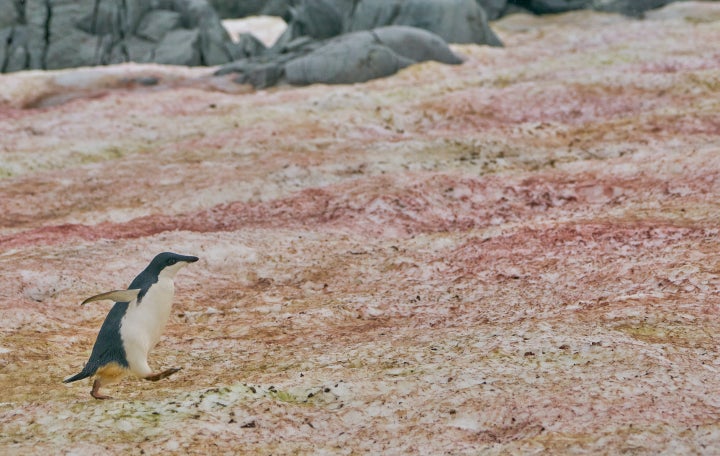The algal blooms that blanket parts of Antarctica’s snow cover in the summer are likely to expand as the planet warms, researchers say in a new study.
A research team from the University of Cambridge and the British Antarctic Survey used satellite data and on-the-ground observations to put together the first large-scale map of green algae across the coast of the Antarctic Peninsula.
Green snow algae is found in warmer areas along the coastline where summer temperatures are above freezing, but still cold enough for there to be snow, say scientists in a study published Wednesday in the journal Nature. It’s also more abundant in areas in close proximity to nesting sites and gathering places for animals like penguins and seals, whose feces fuel the algae’s growth.
Green algae isn’t new for Antarctica ― it’s known to have been there to some degree for decades, New Scientist notes. But what researchers found suggests that climate change could have a major impact on algae in Antarctica, which, in turn, could have its own impact on a warming planet.
The scientists don’t predict that green algae will spread on all parts of the peninsula. In fact, some small low-lying islands are likely to lose algae, because those islands may lose their summer snow cover altogether ― and the snow algae can’t grow without snow. But they predict the amount of green algae is likely to grow on larger pieces of land, where it can spread upward to higher ground that still has snow.
“As Antarctica warms, we predict the overall mass of snow algae will increase, as the spread to higher ground will significantly outweigh the loss of small island patches of algae,” University of Cambridge researcher Andrew Gray said in a press release.
So what does more algae mean, besides turning the landscape green? It’s not totally clear. The green algae works as a carbon sink ― the current amount of algae in Antartica pulls about 500 tons of carbon from the atmosphere each year. On the other hand, algae also makes the surface of the snow darker, which leads to less sunlight being reflected from the snow’s surface, Scientific American notes. That means that more of the sun’s heat gets absorbed, speeding up warming.
Additionally, Antarctica has other algae as well ― large red and orange algal blooms, which the scientists plan to research and map in future studies.

University of Cambridge researcher Matt Davey said in a video about the study that the overall goal of their work is a greater understanding of the “complex connections” between different life forms in Antarctica.
“The more we understand, the more we can protect our planet and its fragile ecosystems that could be lost or changed forever,” he said.
https://news.google.com/__i/rss/rd/articles/CBMiZGh0dHBzOi8vd3d3Lmh1ZmZwb3N0LmNvbS9lbnRyeS9ncmVlbi1zbm93LWFsZ2FlLWFudGFyY3RpY2EtY2xpbWF0ZS1jaGFuZ2Vfbl81ZWM5NjcyNmM1YjZhMTFiOGJlNzY1ZGHSAT9odHRwczovL20uaHVmZnBvc3QuY29tL3VzL2VudHJ5L3VzXzVlYzk2NzI2YzViNmExMWI4YmU3NjVkYS9hbXA?oc=5
2020-05-23 19:28:53Z
52780798356169



Tidak ada komentar:
Posting Komentar